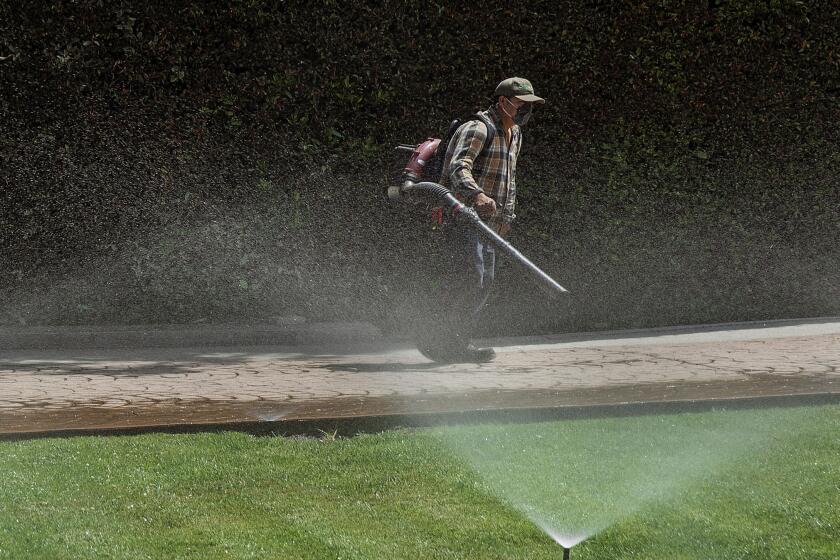The Land Progress Forgot : William Orcutt’s vacation home is now owned by Los Angeles, but it still is a good place to get away from it all.
- Share via
WEST HILLS — I think that I shall never see
A billboard lovely as a tree.
Indeed, unless the billboards fall
I’ll never see a tree at all.
--Ogden Nash
Traversing the crowded streets of the San Fernando Valley can make anyone long for the relaxing shade of a tree and the mellow trickle of a stream. That kind of peacefulness is closer than you think.
Go to the west end of Roscoe Boulevard and discover the Orcutt Ranch Horticulture Center. Here, on 24 acres of what was formerly William Orcutt’s 200-acre ranch, there are majestic oak trees hundreds of years old, a historic Spanish-style adobe house, a creek, nature trails, fruit orchards, rose gardens, community garden plots, picnic tables and a multitude of exotic trees, plants and shrubs.
Orcutt, a geologist who found one of the first prehistoric skeletons at the La Brea tar pits and eventually became vice president of Union Oil Co., bought the property in 1917 as a vacation home. Called Rancho Sombra del Roble (Ranch of the Shaded Oak), it extended east to what is now Woodlake Avenue, west to Valley Circle Boulevard, south to Cohasset Street and north to the Chatsworth Reservoir. In 1966, the city of Los Angeles bought the land.
10:30 a.m.: Enter the ranch through the gate off Roscoe Boulevard and park in the gravel-covered lot. To the right, rising above an orchard, you’ll see the old hot-air windmills used to keep frost from settling on the trees.
Circle a towering oak and examine the restored plows, cultivators and other machinery of a bygone era. Acorns from this tree are still used in a seedling program.
10:45 a.m.: Walk south along the gravel road toward the information board. There’s a reason for the gravel: It acts as a water filtering system, to help rejuvenate the trees. The red barn to your right was once the site of a co-op the Orcutts provided for local farmers to sell their crops.
The information board features an easy-to-read map, a brief history of the Orcutts, and a description of the trees and shrubbery on the ranch. You might be taken aback to learn the swastika was an ancient Indian symbol of peace, which Mary Orcutt incorporated into the home’s architecture years before the Nazis turned it into a symbol of hate.
11 a.m.: Follow the nature trail to what Orcutt historian Helen Treend describes as “our baby oak tree forest.” The trees in this area are about 75 years old. Grade-schoolers on field trips are told, “These are the trees that your great-grandchildren are going to see.”
11:15 a.m.: Continue along the nature trail to Dayton Creek. Walk along a bridge that reflects the original structure. Listening to the wind in the trees, you forget you’re five minutes from civilization.
11:30 a.m.: Follow the creek along the southern border of the property, and use the road to cross over to enjoy a picnic meal at one of three oak-shaded picnic areas. There’s plenty of room for kids to run around, but the area is large enough to provide solitude for those who seek it.
12:15 p.m.: Take the eastern exit out of the picnic area and notice the plaque in front of the Bicentennial Oak, which is about 700 years old and 32 feet, 11 inches in circumference. Another plaque explains how wood from the trees was hauled to a kiln and burned with limestone to make mortar for the building of Mission San Fernando in 1797.
12:30 p.m.: Follow the trail to the wrought-iron gate near Justice Street that used to serve as the main entrance to the property. Turn back toward the creek and head toward the citrus orchards on the right--”an operating orchard just like it was done in the early 1900s, when the Orcutts lived here,” observed Jim Wilson, the park maintenance supervisor. Continue on the dirt road toward Roscoe and the fenced garden plot area ahead.
12:35 p.m.: There are 120 plots, each 10 by 20 feet, available to the public for an annual fee of $20. Inquiries are taken in January. “There’s room to grow enough vegetables for a family of four,” Wilson said.
12:45 p.m.: Follow the road left, toward the huge oak ahead. This tree was dedicated to Ernesto Cornejo, who worked as a gardener at the ranch from 1929 to 1979. The rose garden and house just beyond the tree provide a spectacular scene.
1 p.m.: Enter the rose garden, which features several hedges, statues, a grotto and a large inlaid tile sundial.
1:15 p.m.: Cross the path to a gazebo, the most popular spot for weddings held March through November. This area was originally used for Orcutt picnics and celebrations. It includes an old potting shed and barbecue.
1:30 p.m.: Cross back over the path to the house, and walk around until you enter the courtyard, which features a tile fountain. It’s the perfect place to end a visit.
Gary Klein writes regularly for The Times.
Where and When
What: Orcutt Ranch Horticulture Center, 23600 Roscoe Blvd., West Hills.
Hours: 8 a.m.-5 p.m. daily. Docent-led tours, 2 to 5 p.m., the last Sunday of every month except July and August. Weddings and private tours can be arranged through special events office.
Price: Free.
Events: A public fruit harvest every year on the first weekend after the Fourth of July. Price is $2 for participating in the harvest. Proceeds go to restoration of gardens and orchards.
Call: (818) 346-7449 between 9 a.m. and 5 p.m. Monday through Friday. For garden plot information, call (818) 883-8531.
More to Read
Sign up for The Wild
We’ll help you find the best places to hike, bike and run, as well as the perfect silent spots for meditation and yoga.
You may occasionally receive promotional content from the Los Angeles Times.







